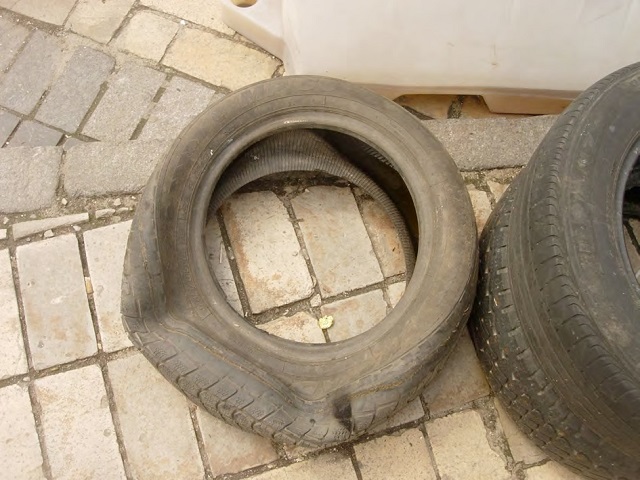07 2014
On Maidan Uprising and Imaginary Archive Kyiv
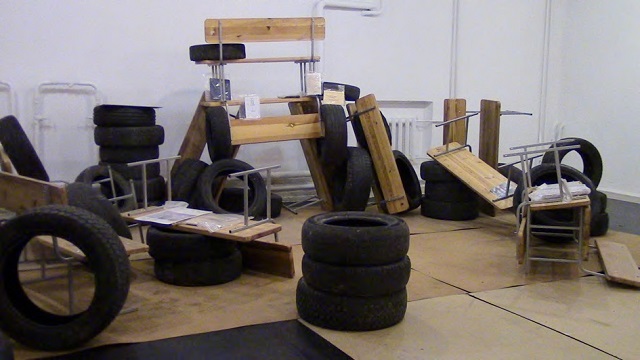
Imaginary Archive Kyiv still under construction in the basement of Les Kurbas Center, Ukraine, April 23, 2014
With a sharp tug the soot-covered tire slides free from a pile stacked over my head. Then another. And another. Soon I have fifteen tires loosened. It’s April 22, 2014, and along with local curator Larissa Babij I am standing on the battle-charred northeast corner of Kyiv's Independence Square known locally as Maidan (square). Only a few months earlier the state’s special military units and riot police confronted an assortment of extra-paramilitary forces and ordinary citizens here as they attempted, and ultimately succeeded, to oust their corrupt President Viktor Yanukovych from office. Throughout the battle DIY barricades appeared across all the streets leading to Maidan. Stacked three and four meters high these improvised barriers combined wood shipping pallets with packed ice and assorted objects from benches to pieces of the dismantled city-sponsored Christmas tree to automobile tires. The barricades were built to impede the advance of pro-Yanukovych forces, while simultaneously protecting the square’s motley crew of demonstrators. Now, after the events of February, these barricades are less functional and more like monuments. Perhaps that is why we were able to cut a deal with the local Maidan "self-defense" to relocate scores of tires to Les Kurbas National Theatre Arts Center, a nearby cultural space where the Ukrainian edition of Imaginary Archive (IA) is being hosted.
IA is a traveling installation that I have organized together with curator Olga Kopenkina and with technical assistance from Matt Greco. For this occasion Larrisa Babij makes up the fourth member of our team. IA consists of dozens of artist-generated “documents” each of which represents a past whose future never arrived. As it moves from country to country local artists contribute new fictitious histories, which despite their fantastical dimension manage to address concrete political, historical and social struggles. So far IA has appeared in New Zealand (2010), Ireland (2011), Austria (2013) and now Ukraine (2014). A principle aim of the project is to release the utopian dimension of history, or as a reporter from Ukrainian Pravda described IA,
“At a time when living impressions and personal memory are no longer a reliable instrument for "digesting" the endless stream of events, the need for an alternative approach to understanding the history, which is unfolding before our eyes, becomes more than relevant.” (Ukrainian Pravda, 4/5/2014)[1]
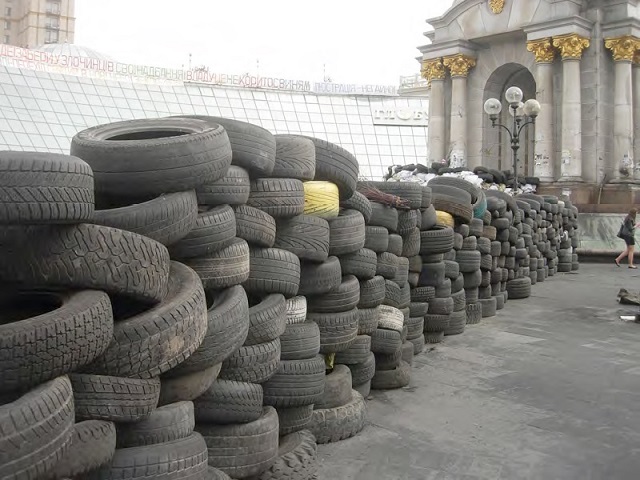
Stacks of tires above the underground shopping complex Globus with the gilded columns of the Monument to Independence both added to Maidan in 2001 as a way of transforming the square into a consumer complex.
And so we gather up these readymade materials, rolling them one by one into a waiting cargo van that is quickly filled to capacity. Yet even as we do so small units of camouflaged men huddle about Maidan on this chilly spring morning. Some chop firewood. Others peel potatoes and tend stoves. They remain stationed here 24-7, presumably dug-in “just in case.” (Or is it because the entire square is now charged with historical significance, or more accurately, with multiple auras of signification?)
Meanwhile, Kyiv’s residents swarm between these grimy, makeshift obstacles heading to and from work. At certain points their flow is reduced to a single-file. In other words, the barricades still function. Before we pull away I tuck some folded Hryvnias into a plastic donation box adorned with a small Ukrainian flag. It amounts to only a few US dollars, but in an extraordinarily imploded economy valuable nonetheless. The blue and gold flag is sealed beneath several layers of yellowing packing tape and it dawns on me then that both the tape and the box and the tires are all made from the same petrochemical ingredients that sparked the Maidan uprising. It was Yanukovych’s Kremlin deal, which had aimed to slash Russian gas import prices in exchange for securing Moscow’s vital oil pipelines across Ukraine into Europe, that brought masses of anti-Russian, pro-EU demonstrators into public squares and spaces starting November 21st. Dubbed Euromaidan (ЄВРОМАЙДАН) via Twitter and then by the press, the crisis peaked on February 22 when Yanukovych fled into exile in Russia, though not before government-loyal forces killed over one hundred protestors, many were shot by unmarked snipers along Institutskaya Street, not far from the National Art Museum.[2]To détourn a Situationaist slogan: Beneath the streets, petropolitics: above the streets, blood, tires, chaos.
Easy to acquire in large numbers pneumatic automobile tires have become the “cobblestones” of 21st-century uprisings. Made primarily of Styrene-butadiene copolymer they roll naturally into position and yet are light enough to be stacked into tall, unyielding barriers. But it is thanks to their mostly synthetic carbon composition that their superiority to paving stones becomes evident. At about 140 degrees Celsius (284 Fahrenheit) tires combust, thus amplifying their usefulness as barricades separating protesters from police, protesters from other protesters as things turned out in Ukraine. For while at first Maidan was a swarm of intermingled Ukrainian bodies –far right ultranationalists, middle right and middle middle patriots, and even a small liberal-left made up of feminists, anarchists, and anti-Stalinist neo- Marxists. These latter forces never coalesced into a block yet still continue to meet and exert force. In general, precise lines of political stability were difficult to draw on Maidan. Certainly, from the outset in December there was conflict - often violent - between protesters with varied or opposing political leanings, especially a number of incidents where leftist (sometimes specifically feminist or anarchist) activists were attacked for their political inclination by right activists claiming that there is no place for leftists on Maidan. Still, there was a unified objective to all this opposition: oust the Yanukovych government. After the government fell this mishmash of positions grew less muddled. Insignia and slogans, many of them reflecting strident Christian beliefs and others archaic historical imagery, all began to crystallize into an array of distinct positions. As if a series of micro-nations had sprung up overnight on Maidan with each minute-grouping generated its own rules, identifiable mottos and imagery, as well as bureaucratic structures.
Imaginary Archive’s participants belonged by and large to the small, liberal-Left intellectual sector. By one artist’s estimate it consists of between seventy and a hundred people. Passionate though disorganized, seriously outnumbered, their brief presence on Maidan was easily foiled by men wielding clubs. Not surprisingly many artists turned to the cultural sphere to express their resistance. In the summer and fall of 2012, about a year before the massive Maidan Square protests, many of these artists worked in coordination with staff at the National Art Museum of Ukraine to pressure the Ministry of Culture into hiring a competent director who would prioritize the interests of the museum as a public institution over personal ambitions and political ties. Not unlike Art Workers' Coalition from NY in the late 1960s/early 70s or Occupy Museums today these artists engage in direct action, the wellspring of "institutional critique." The Art Workers' Self-defense Initiative's manifesto reads in part:
"In a country that declares democracy the preferred mode of interaction, we, as art workers, must impact the formation of new cultural policy principles and how they are put into practice." (ICTM 2014)[3]
But mass political-cultural uprisings today are seldom the sole province of political progressives. Maidan was no exception. What is striking about the Ukrainian revolution is the degree to which a previously shadowy sphere of ideological interests rapidly cohered through acts of self-representation thanks to a combination of populist activism, networking technology, and a significantly weakened central state. And perhaps there is a link between Ukrainian "zhlob-art" with its overtly folksy kitsch paintings of unemployed citizens and Maidan’s improvised plywood shields behind which men bore sticks, rods and makeshift wooden maces.[4] At one point protestors constructed a Molotov cocktail launching contraption that resembled a medieval catapult. On another day babushka flashmobs sang quaint Ukrainian folksongs. Illuminated by pyres of flaming tires this brightening slew of unrestrained fantasies, some at least partially real, though all decidedly heroic, flared rapidly into visibility. As Babij notes,
“Maidan became a platform for certain zhlob-artists to demonstrate their own righteous patriotism and also for accusing other artists (especially those same leftists who were already unwelcome in the square) of not being active enough, especially in day-to-day presence on the square. I bring them up not because I find their work, political positions, or modes of operating in the public sphere sympathetic or thought-provoking; what astounds and disturbs me is their extreme popularity, a kind of channeling of aggressive, populist, patriotic and anti-Other sentiment and their support in the glamour- and scandal-craving wider Ukrainian contemporary art scene. You may recall the photo of some art exhibition that opened just after IA with a photo of "Russians" in a cage…”
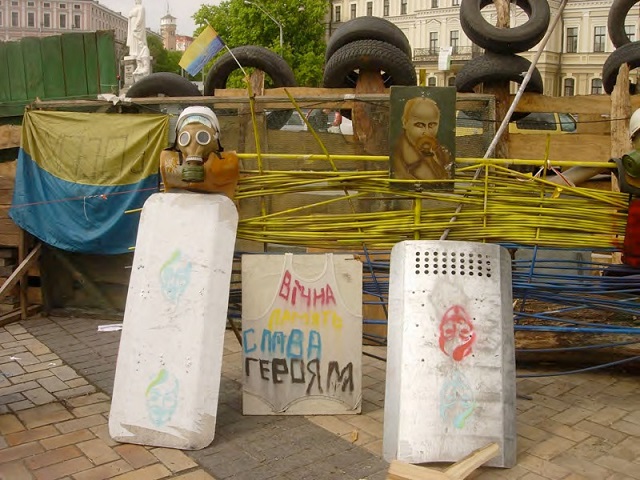
Improvised barricades, shields and other protest equipment in front of St. Michael’s Church downtown Kyiv, Ukraine, April 2014
The unleashing of Maidan’s imaginary archive is just one of many recent examples in which a previously unrepresented cultural mass or “dark matter” has generated its own public presence.[5] Yet even as this process of brightening opens-up progressive possibilities, it also allows space for reactionary tendencies to gain visibility and coherence. Still, if we sympathize with the “counter-publics” thesis expressed by Kluge and Negt that “throughout history, living labor has, along with the surplus value extracted from it, carried on its own production—within fantasy,” then the anachronistic and mythopoetic imagery often of Euromaidan comes as no surprise.[6] Of course, the political economy of this imaginary production is 6 never neat and orderly. It is instead permeated with hopes as well as resentments. It is also a resource or archive ready to be mined by an ever-expanding culture industry that has moved far beyond the administered Fordist model once proposed by Adorno and Horkheimer. Creativity, collaboration, horizontality; neoliberal capitalism’s new business vocabulary applies equally well to the globalized sphere of art as it does to finance. The rapid illumination of this missing cultural mass has become a primary intake-valve for deregulated enterprise culture. Resistance is not futile however, though it can be costly. Not only in terms of one’s life or career of course, but also politically, as we now see in Egypt in particular.

A composite of imaginary documents photographed in the dark at Les Kurbas Cener, Kyiv, Ukraine, April, 2014.
IA opened as planned on April 23, (2014), however hours beforehand electrical power was cut to Les Kurbas Center. Using small flashlights and a dose of adrenaline Olga Kopenkina, Larissa Babij and I completed the installation. Later on, thanks to a portable generator and some gasoline that participating artist Volodymr Kuznetsov biked in from protestors on Maidan we installed temporary lighting for our guests.[7] After that the exhibition had to be viewed with a flashlight in hand. It now seems that electricity rationing as well as the privatization of previously public utilities led to the sudden cutoff, this despite the fact that Kurbas is a state-funded institution. Babij describes the installation itself as resembling or resonating with “the barricades on Maidan” while remaining “consciously artificial.” She also pointed out that this congruity of real and synthetic structure echoed the more "formal" barricades constructed in eastern Ukrainian cities as they were being taken over by separatists. Most recently the new mayor of Kyiv Vitaliy Klitschko called for cleaning crews to dismantle the Maidan barricades. His efforts were met with angry protestors not ready for a return to business as usual. Instead these barricades are now being tidied up and transformed into genuine monuments to the uprising, and in some places even urban gardens have appeared in Maidan.
Where then does this leave us barricade builders and barricade busters who construct mock-institutional identities to slip between the interstitial spaces of capital? Or what about those who envision the possibilities of progressive dark matter and its imaginary archive? Perhaps by refusing to construct our own absolutist mythologies and by keeping all notions of identity in play we produce a kind of alternative usership to deploy a smart, handy term devised by theorist Stephen Wright.[8] In this scenario art literally attempts to escape its own ontological conditions by seeping out unrecognized into the everyday world. Not that every artist in IA would agree with Wright’s objectives, and some in fact are already established figures within the Ukrainian art scene and beyond. In any case, we seem to have arrived at a moment of great possibility and equally great risk. Meanwhile, the socially conscious intellectual never surrenders questioning the substrate of his or her discipline, no matter how squalid its conditions, and never loses hope. Dark Matter and Imaginary Archive are just two names for this paradox.
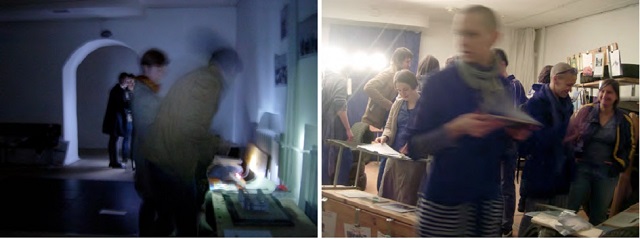
Finalizing installation in the dark followed by opening temporarily powered by a generator and portable klieg lights.
This text has first been published at the Hyperallergic website: http://hyperallergic.com/137799/on-the-maidan-uprising-and-imaginary-archive-in-kiev/.
[1] “A very timely and out-of-the-ordinary project." Ukrainian Pravda, April 5 2014, online at: http://life.pravda.com.ua/culture/2014/05/4/166771/view_print/
[2] Notably those who lost their lives during Maidan protests were of many nationalities and religions and also from all regions of Ukraine - the first person killed was an Armenian, the second from Belarus
[3] Manifesto from ICTM Art Workers’ Self-defense Initiative at: http://istmkyiv.wordpress.com/manifest/
[4] Examples of "zhlob-art" with commentary can be found at: http://www.unitedcreativity.org/central_and_easetrn_europe/ukraine/zhlob-ar.html)
[5] See “Dark Matter: Art and Politics in an Age of Enterprise Culture,” Gregory Sholette, Pluto Press, 2010.
[6] Oskar Negt and Alexander Kluge, Public Sphere and Experience: Toward an Analysis of the Bourgeois and Proletarian Public Sphere, trans. by P. Labanyi, J. O. Daniel and A. Oksiloff and contains a forward by Miriam Hansen, University of Minnesota Press: Minneapolis, 1993, p. 32.
[7] Volodymr Kuznetsov was himself the victim of state censorship when his painted mural "Koliivschina: Judgment Day” depicting government corruption was defaced on July 25th, 2013 by Natalia Zabolotna's, director of the Mystetskyi Arsenal art museum the night before President Viktor Yanukovych was to visit the exhibition. For more about this incident go to: http://www.rferl.org/content/ukraine-art-destroyed-kuznetsov-kievan-rus-yanukovych/25058261.html
[8] Toward a Lexicon of Usership by Stephen Wright, The Van Abbemuseum, Eindhoven, 2014.
